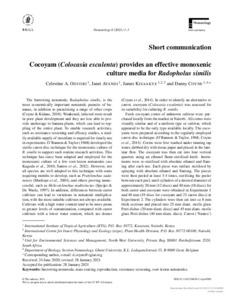| dc.contributor.author | Oduori, C.A. |
| dc.contributor.author | Atandi, J. |
| dc.contributor.author | Kisaakye, J. |
| dc.contributor.author | Coyne, D. |
| dc.date.accessioned | 2021-06-09T09:32:08Z |
| dc.date.available | 2021-06-09T09:32:08Z |
| dc.date.issued | 2021 |
| dc.identifier.citation | Oduori, C.A., Atandi, J., Kisaakye, J. & Coyne, D. (2021). Cocoyam (Colocasia esculenta) provides an effective monoxenic culture media for Radopholus similis. Nematology, 1-3. |
| dc.identifier.issn | 1388-5545 |
| dc.identifier.uri | https://hdl.handle.net/20.500.12478/7130 |
| dc.description.abstract | The burrowing nematode, Radopholus similis, is the most economically important nematode parasite of bananas, in addition to parasitising a range of other crops (Coyne & Kidane, 2018). Weakened, infected roots result in poor plant development and they are less able to provide anchorage to banana plants, which can lead to toppling of the entire plant. To enable research activities, such as resistance screening and efficacy studies, a readily available supply of inoculum is required for timely use in experiments. O’Bannon & Taylor (1968) developed the sterile carrot disc technique for the monoxenic culture of R. similis to support such routine research activities. This technique has since been adapted and employed for the monoxenic culture of a few root-lesion nematodes (see Kagoda et al., 2010; Santos et al., 2012). However, not all species are well adapted to this technique with some requiring months to develop, such as Pratylenchus sudanensis (Mudiope et al., 2004), and others proving unsuccessful, such as Helicotylenchus multicinctus (Speijer & De Waele, 1997). In addition, differences between carrot cultivars can lead to variations in nematode multiplication, with the most suitable cultivars not always available. Cultivars with a high water content tend to be more prone to greater levels of contamination, compared with carrot cultivars with a lower water content, which are denser (Coyne et al., 2014). In order to identify an alternative to carrot, cocoyam (Colocasia esculenta) was assessed for its suitability for culturing R. similis. |
| dc.description.sponsorship | CGIAR Research Program for Roots, Tubers and Bananas |
| dc.description.sponsorship | European Union |
| dc.format.extent | 1-3 |
| dc.language.iso | en |
| dc.subject | Taro |
| dc.subject | Nematodes |
| dc.subject | Rearing Systems |
| dc.subject | Reproduction |
| dc.subject | Screening |
| dc.subject | Lesions |
| dc.title | Cocoyam (Colocasia esculenta) provides an effective monoxenic culture media for Radopholus similis |
| dc.type | Journal Article |
| cg.contributor.crp | Roots, Tubers and Bananas |
| cg.contributor.affiliation | International Institute of Tropical Agriculture |
| cg.contributor.affiliation | International Centre of Insect Physiology and Ecology |
| cg.contributor.affiliation | North-West University |
| cg.contributor.affiliation | Ghent University |
| cg.coverage.region | Africa |
| cg.coverage.region | East Africa |
| cg.coverage.country | Kenya |
| cg.coverage.hub | Eastern Africa Hub |
| cg.researchtheme | Natural Resource Management |
| cg.identifier.bibtexciteid | ODUORI:2021 |
| cg.isijournal | ISI Journal |
| cg.authorship.types | CGIAR and developing country institute |
| cg.iitasubject | Agronomy |
| cg.iitasubject | Crop Systems |
| cg.iitasubject | Plant Breeding |
| cg.iitasubject | Plant Diseases |
| cg.iitasubject | Plant Production |
| cg.journal | Nematology |
| cg.notes | Open Access Article; Published online: 05 Mar 2021 |
| cg.accessibilitystatus | Open Access |
| cg.reviewstatus | Peer Review |
| cg.usagerightslicense | Creative Commons Attribution 4.0 (CC BY 0.0) |
| cg.targetaudience | Scientists |
| cg.identifier.doi | https://dx.doi.org/10.1163/15685411-bja10088 |
| cg.iitaauthor.identifier | Daniel Coyne: 0000-0002-2030-6328 |
| cg.futureupdate.required | No |

